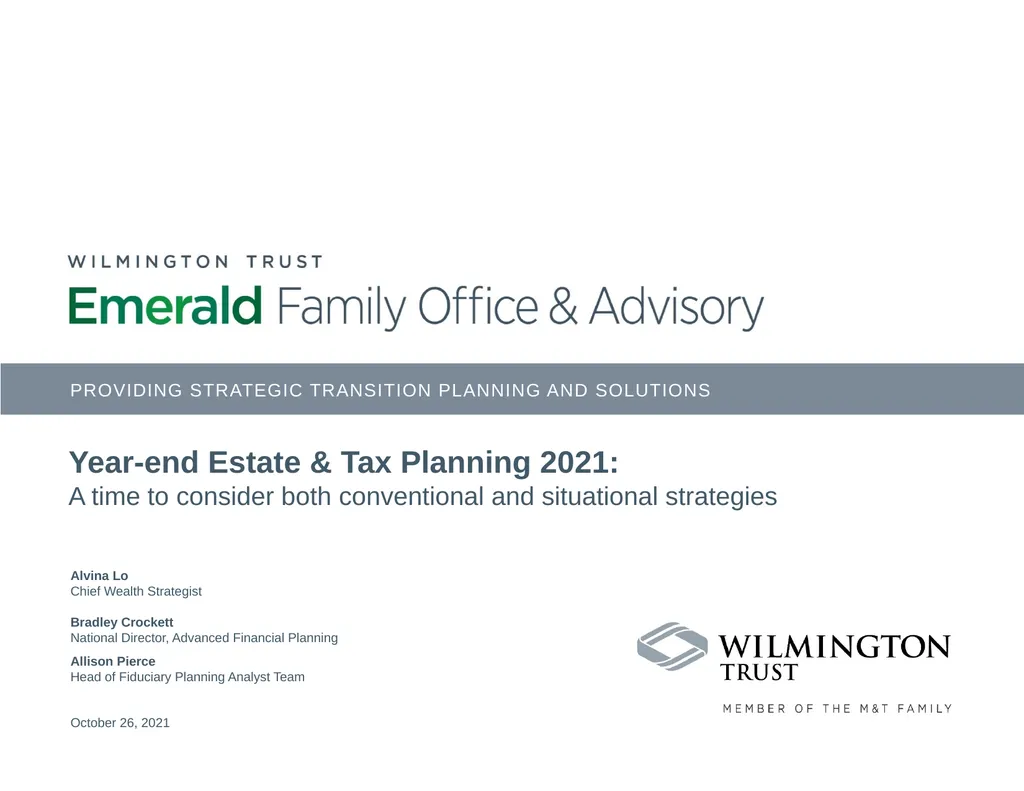PROVIDING STRATEGIC TRANSITION PLANNING AND
Author : natalia-silvester | Published Date : 2025-05-14
Description: PROVIDING STRATEGIC TRANSITION PLANNING AND SOLUTIONS Alvina Lo Chief Wealth Strategist Bradley Crockett National Director Advanced Financial Planning Allison Pierce Head of Fiduciary Planning Analyst Team October 26 2021 Yearend Estate
Presentation Embed Code
Download Presentation
Download
Presentation The PPT/PDF document
"PROVIDING STRATEGIC TRANSITION PLANNING AND" is the property of its rightful owner.
Permission is granted to download and print the materials on this website for personal, non-commercial use only,
and to display it on your personal computer provided you do not modify the materials and that you retain all
copyright notices contained in the materials. By downloading content from our website, you accept the terms of
this agreement.
Transcript:PROVIDING STRATEGIC TRANSITION PLANNING AND:
PROVIDING STRATEGIC TRANSITION PLANNING AND SOLUTIONS Alvina Lo Chief Wealth Strategist Bradley Crockett National Director, Advanced Financial Planning Allison Pierce Head of Fiduciary Planning Analyst Team October 26, 2021 Year-end Estate & Tax Planning 2021: A time to consider both conventional and situational strategies Ordinary income tax Increase highest marginal tax rate from 37% to 39.6% Effective date: January 1, 2022 Capital gains tax Increase the highest marginal long-term capital gains rate from 20% to 25% Effective date: September 13, 2021 Estate planning Reduce estate and gift tax exemptions from $11.7 million per person to $5 million (indexed) Effective date: January 1, 2022 Severely eliminating the effectiveness and use of grantor status in newly created trusts Effective date: TBD The House Ways and Means Committee has proposed federal legislation that may significantly impact individuals and families in several key areas: Potential Federal Tax Law Changes Routine Year-End Planning Income Tax Mitigation Conventional wisdom: Minimize tax by deferring income Maximize deductions Contribute to tax-advantaged accounts: 401(k)s and IRAs Double tax advantage Reduces current year taxable income Tax-deferred growth HSAs Triple tax advantage Reduces current year taxable income Tax-free growth Tax-free distributions for qualified medical expenses Offsetting Capital Gains Tax-loss harvesting: Realization of capital losses to offset taxable gains Key considerations: Avoid the wash sale rule Avoid repurchase for 30 days, before or after selling the loss generating security Purchase a similar but not “substantially identical” security Maintain your investment strategy Don’t let tax mitigation cause you to sell assets that play a strategic role in your portfolio Annual Exclusion Gifting Tax-free gifting: Every individual can make a $15,000 tax-free gift annually $30,000 for married couples No limit to number of recipients Popular strategies: Outright gifts or in trust 529 education savings plans Limit the use of a gift made to children Provide for long-term education funding Direct payments to medical or educational institutions do not count toward annual exclusion Estate Plan Review Year-end estate plan review: Helpful to ensure your wishes for distribution are met Key considerations Do you have a complete plan in place? Will Trust Powers of attorney for health or financial matters Who have you named to act? Key fiduciaries: executor, trustee, agents (health and financial) Ensure they can fulfill their roles Are your beneficiary designations current? Review named beneficiaries of retirement accounts, life insurance policies, and transfer-on-death accounts Situational Year-End Planning: Playing Defense Defensive Strategies: Offsetting Ordinary














